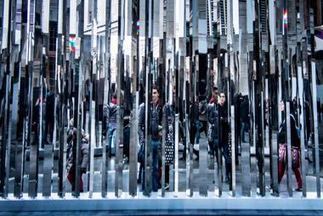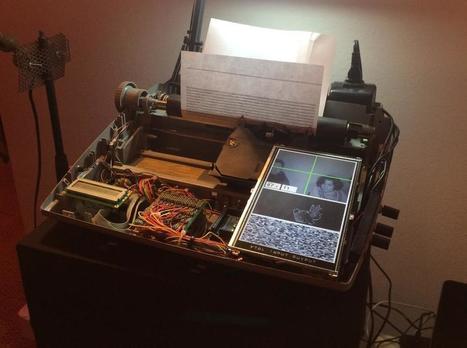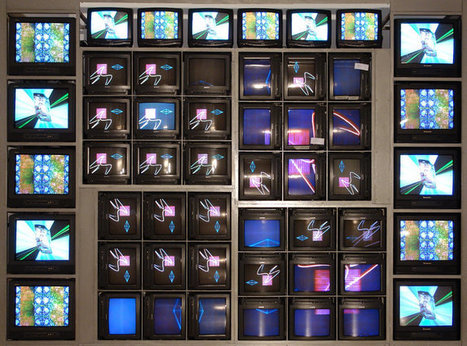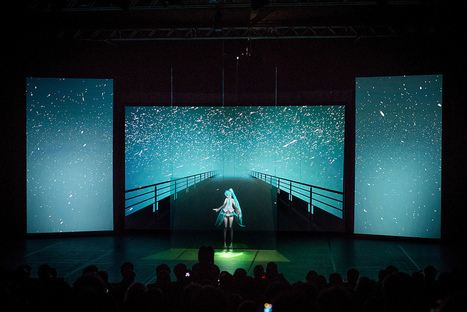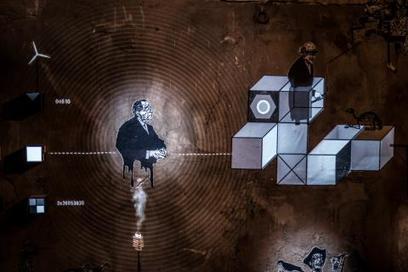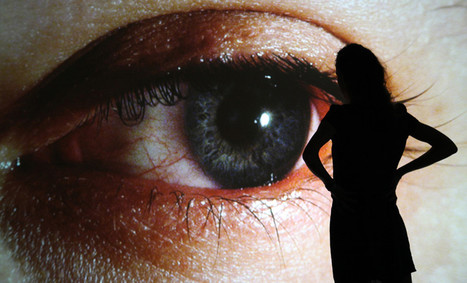 Your new post is loading...
 Your new post is loading...
Cet hiver, Arcady et le CentQuatre proposent au Cent Quatre Paris, en point d’orgue de la Biennale Des Arts Numériques d'Arcady Némo 2015, une grande exposition spectacle d’art(s) et de technologie(s) nommée Prosopopées Et, quand les objets prennent vie, s'étonne t'on encore ? L’exposition, que dis-je, le spectacle Prosopopée dont le sous titre propose un vrai programme paranormal où la magie est annoncée, pose en filigrane une grande question : Peut-on encore être étonné avec de l’art contemporain ? Pour sa préfiguration, le Fresnoy (Studio national des arts contemporains) proposait déjà les Arts étonnants une exposition de groupe qui explorait les nouvelles forme d’immersion artistiques avec une prépondérance aux concepts de l’étonnement artistique. Or au Cent Quatre, 20 ans après, était-ce nécessaire de nous imposer les technologies et le numérique comme seuls vecteurs d’étonnement artistique. Le coefficient de numéricité cher à Norbert Hilaire et Edmond Couchot serait-il conjugable avec un coefficient d’étonnement ?
La quatrième édition du Mirage Festival rassemblait du 02 au 06 mars dernier plus de 8500 personnes sur une dizaine de lieux dans tout Lyon. C’était également l’occasion de découvrir une fois de plus des œuvres, installations ou performances, originales et pertinentes, symboles de ce « réenchantement du quotidien » (voir notre article) proposé cette année par la manifestation lyonnaise, présentées sous le thème « Techno-Fiction ». Panorama
Among the topics examined are the use of commercial platforms for art practice, what art means in an age of increasing surveillance, and questions surrounding such recent concepts as “postinternet.…
Publisher The MIT Press writes: Since the turn of the millennium, the Internet has evolved from what was merely a new medium to a true mass medium—with a deeper and wider cultural reach, greater opportunities for distribution and collaboration, and more complex corporate and political realities. Mapping a loosely chronological series of formative arguments, developments, and happenings, Mass Effect provides an essential guide to understanding the dynamic and ongoing relationship between art and new technologies...
La 11e édition de la conférence Lift qui se tenait à Genève s’est ouverte avec une session sur la fameuse Blockchain. Cette technologie cristallise aujourd’hui tous les espoirs de décentralisation et d’autonomie, à la suite de tant d’autres technologies qui ont connu leur heure de gloire avant d’être assimilées sans avoir vraiment réalisé ces mêmes promesses. Comme si cette longue histoire de déceptions et d’échecs n’avait finalement eu aucun impact sur l’enthousiasme des évangélistes des nouvelles technologies. A croire que la révolution technologique est toujours une révolution à venir…
Created in Normandie 10 years ago, ]interstice[ meeting of the unclassified continues to celebrate sound and visual art. In ssociating those artistic forms open to multiple lectures, the festival initiates reflection on contemporary creation and technology and invests itself in those spaces within the city which, to quote Pierre Sansot in Poétique de la Ville “ composes and recomposes itself, at each instant, by the steps of its inhabitants”. A church that is reborn at the ringing of its bell, a hypnotic cascade, a choir of sewing machines, with threads that cut through the space, a wooden MÉCANO resounding its playing with its own sonic material, explosions of particles, earthquakes, lightning bolts, the interstellar vibration beneath our feet, the infinity of water, a sonic discovery of the city...
The festival is not only an ensemble of works, performances or shows, but also a workshop, and a meeting for the artists. Their devotion and their attention are added encouragement in this regard. At this moment, this tenth anniversary, we invite those artists that have marked and supported our efforts such as Nicolas Tourte (2008), Cécile Beau et Nicolas Montgermont (2009, 2012), Arno Fabre (2011, 2013) et Herman Kolgen (2012). The public is also called to make the acquaintance of korean artist HeeWon Lee, Martin Messier from Canada, Aernoudt Jacobs of the belgian collective Overtoon, Julien Poidevin, Franck Vigroux, Nicolas Talbot...
In partnership with Relais d'sciences and le Pavillon, ]interstice[ proposes new encounters aiming to identify new interests, new forms of collaboration and contact with the public : living lab workshops, conferences/seminars and commented parcours for 'unguided' visits. This tenth edition is the occasion to sincerely give thanks for all of our supporters, without whom the festival would not exist. The territorial collectivities and the state, who maintained or reinforced their engagement in the project, all of the institutional partners, associative and private and all of their teams contribute to the brilliance of an event consecrated to creation and its free access and visibility. The festival is known for its respect of the artists, the work and the public. There would not be a festival without the volunteering of the production team and the the students and alumni of the école supérieure d’arts et médias of Caen/Cherbourg, contributing to the professional realization of all of the exhibitions, the welcoming of the artists and the public. Each edition is a fragile construction that walks the tightrope of constraints and all this permits ]interstice[ to exist.
An exhibition at the Whitechapel Gallery in London explores how the digital age has influenced artists.
LONDON — Smiling energetically, a video projection of a woman appears to be welcoming visitors to the Whitechapel Gallery here. But on approaching the work, “Homo Sacer,” by the British artist and writer James Bridle, she instead issues bureaucratic sound bites. They include text from the letter that stripped the terror suspect Mohamed Sakr of his British citizenship, two years before he was killed by a United States drone strike in Somalia in 2012. “I was fascinated that someone born in the United Kingdom could have their citizenship removed,” Mr. Bridle said. “This work is essentially a step-by-step guide on how you can go from being a British subject to being placed in the legal position of being able to be killed.”
La Transmediale sait brouiller les pistes. Elle se qualifie “festival”, mais cache derrière ce terme le rendez-vous pointu d’une communauté qui s’interroge.
Sous ses airs de célébration de la culture des hackers-artistes-makers, elle questionne moins les bricoleurs 2.0 que ceux qui (dé)font la loi dans l’ère du capitalisme post-numérique (postdigital). Loin d’être une fête de l’imprimante 3D et du prototypage ou un festival d’installations interactives monumentales, la Transmediale est un temps pour suspendre l’effervescence du monde actuel et mettre sur la table les questions qui dérangent/démangent.
On était au rendez-vous pour la 29ème édition, on vous raconte...
A la 29ème Transmediale, à Berlin du 2 au 7 février, des tribunes et des discussions plutôt que des expositions, autour de la défense des libertés civiles et de l’autonomie numérique dans une Europe sous tension. Après-coup.
Si l’an dernier le rendez-vous des médias tactiques s’était intéressé à la marchandisation des big data dans nos sociétés du contrôle social, le directeur artistique, Kristoffer Gansing, a choisi pour l’édition 2016 de focaliser sur notre société « anxiogène ». Une anxiété traduite par la continuelle et nécessaire tension qui mène les hackers, makers et activistes médias, dans leur volonté de rester indépendants et agents des transformations démocratiques de la société...
|
De jeunes hommes bénévoles, futurs VR designers, nous accueillent à la Gaîté lyrique le mardi 1er mars 2016 à Paris, équipe médiatrice pour le compte d’un World Tour VR, la soirée KALEIDOSCOPE. Quelques rares jeunes femmes, nos bracelets VIP et les casques. A gauche, les Gear VR de chez Oculus rachetés par Facebook négociés made in Samsung, à droite les HTC Vive et plus loin les DK2. O monde cruel. D’une marque à l’autre. Cela fait plus de trente années que l’on se tape la technologie avant la poésie. Rebelote. Le très joli programme de papier distingue les 32 réalisations immersives par marque de casque. ...
Du 19 février au 21 mars 2016, Digital Choc revient pour sa 5e édition. Organisateur du festival tokyoïte, l’Institut français du Japon y présente une programmation strictement franco-japonaise. A travers un thème intitulé “futurama”, les artistes invités explorent le futur et interpellent par leurs regards hétéroclites. Ce mélange bi-national et les différences culturelles qui en découlent, rendent l’événement tout particulièrement fascinant. Digital Choc a le mérite de se positionner au croisement de deux cultures fortement reconnues pour leur créativité dans le champs numérique. Pourtant, s’il existe une réelle admiration des Français pour l’art nippon, peu d’artistes japonais associés à la scène numérique sont encore connus dans l’Hexagone. La réciproque est tout aussi vrai, au point que certaines célébrités nationales, comme 1024 Architecture, peuvent n’avoir quasiment jamais été présentées au Japon. L’Institut français du Japon, à l’initiative du festival Digital Choc, permet une perspective nouvelle sur ces deux pays. Il s’agit ici de créer une passerelle entre quelques uns des artistes les plus prometteurs et de faire rayonner deux cultures numériques incontournables dans divers lieux phares de Tokyo. ...
Une prosopopée est une « figure de rhétorique par laquelle l’auteur prête la parole à un absent ou à un être inanimé », nous explique le dictionnaire Larousse. C’est également le grand thème transversal adopté par Némo, Biennale internationale des arts numériques, qui bat son plein à travers l’Ile-de-France depuis début octobre et dans le cadre de laquelle le Centquatre accueille l’exposition éponyme. Avec humour et poésie, cette dernière entraîne le visiteur au cœur d’un monde étrange, habité d’objets, pour la plupart inutiles, rendus autonomes par la grâce de la technologie numérique ; un joli pied de nez à la culture dominante du tout connecté. « On vous propose une revue d’objets déconnectés, un grand dérèglement ; plus rien ne va, ça se situe entre Roland Barthes et Bart Simpson ! », résumait en souriant, à l’ouverture de l’exposition début décembre, le directeur de la biennale Némo Gilles Alvarez, ayant conduit avec son homologue du Centquatre, José-Manuel Gonçalvès, la direction artistique de Prosopopées : quand les objets prennent vie. Tout en banalisant le recours au numérique, la proposition, qui réunit une trentaine de sculptures et installations de plasticiens internationaux, entend favoriser une posture critique par rapport au contenu numérique et à la société connectée qui est la nôtre. En témoigne avec force ironie, non dénuée d’onirisme, L’appartement Fou, déployé au sous-sol dans les Ecuries. « On nous fait croire que nous sommes entourés d’objets intelligents, qui vont améliorer notre sort, faire des choix à notre place, reprend Gilles Alvarez.
Huge stroboscopic datastreams, hypnotic human-machine choreographies, a cacophony of Korean, Japanese, English, German, and French – ten weeks ago, from November 25th to 28th 2015, an unlikely cross-cultural exchange took over the all new ACT Center in Gwangju, South Korea. More than a hundred artists, designers, curators, and educators – local, regional, international – had answered our invitation to add their work and voice to the inaugural edition of ACT Festival, a four-day opening celebration of the center’s monumental facilities and the first of many programming highlights to come. The goal: have the world’s best and brightest discuss the state of craft and creation in the digital age.
On October 13, 1966, 10 artists and more than 30 engineers from Bell Laboratories convened in New York for 9 Evenings: Theatre and Engineering. The festival ran for nine nights, and featured 10 performances in which an artist, dancer, or musician was paired with a Bell engineer who had the technical expertise to bring the performer’s vision to life. This meant building tools like a proportional control system, an electronic pen and surface interface to control lights and audio during a performance, and televisions and projectors capable of producing kinetic images in response to sound. This partnership was good for the artists, and fantastic for Bell’s engineers: it provided a stage upon which they could prototype the future of the tech sector. ...
Big Bang Data is a major travelling exhibition currently set within London’s Somerset House. That a large institution is presenting a journey via data capture through ‘selfies, surveillance and infographics’ is in itself an interesting patchwork of intent and realisation. The aim of the exhibition is to ‘demystify data’. This is a grand, summative and in actuality slightly awkward claim which, in my view, encapsulates the character of an interesting, textured exhibition in an unintentionally astute way.
As Big Bang Data is dedicated to revealing data comprehensively through its various architectures and iterations, it makes sense for the underrepresented materiality of information to have prominence early on. This materiality, perhaps inevitably, was compromised in the gallery space. Entering the first room brings you face to face with Timo Arnall’s Internet Machine, which takes the form of multiscreen video documentation of not just the machines, but also the architecture, which supports mobile telephony. ...
exhibition : 03 December 2015 - 20 March 2016
website : http://bigbangdata.somersethouse.org.uk
“The Game Worlds of Jason Rohrer,” in Boston, is the first major museum retrospective dedicated to a game designer’s work.
In April 2010, a brouhaha erupted in the gaming community that still reverberates today: The film critic Roger Ebert had opined that video games could never truly be counted as art. “Let me just say that no video gamer now living will survive long enough to experience the medium as an art form,” he wrote on his blog. But three months later, in an erudite follow-up titled “Okay, Kids, Play on My Lawn,” he recanted. Great works of art, he speculated, “could instruct me about life, love, disease and death, principles and morality, humor and tragedy.” Ebert admitted that he hadn’t spent enough time with video games to know if they could, indeed, evoke these feelings. “I don’t know if they can be inspired to transcend themselves,” he wrote. “Perhaps they can. How can I say?”
The relationship between art, science, and technology has a long and complex tradition in Poland, going back to the experiments of the first avant-garde.
Interest in new technologies on the part of artists has always been an important element of the development of art, but it was only in the 1960s that the creative practices known today as the main reference point for technological art were established. Such new initiatives appeared in the Poland of the 60s, during the Thaw period, when the attitudes towards activities at the interface of art, design, and technological development were much more accepting. This includes, among others, works created at the Polish Radio Experimental Studio, as well as the artistic practices stemming from Mieczysław Porębski's seminars, devoted to the relationship between art, science, and technology (participants included Ryszard Winiarski, Feliks Falk, and Grzegorz Kowalski).1 Other artistic phenomena involving art and technology include some works created at the Workshop of the Film Form, and the later solo works by such Polish artists as Krzysztof Wodiczko or Zbigniew Rybczyński...
|



 Your new post is loading...
Your new post is loading...

